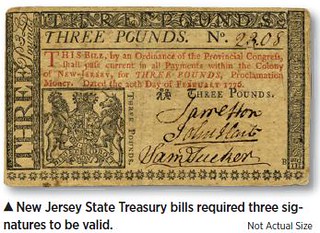
PREV ARTICLE
NEXT ARTICLE
FULL ISSUE
PREV FULL ISSUE
THE 1776 NEW JERSEY STATE TREASURY RAID
Ray Williams had an interesting article in the December 2015 issue of The Numismatist, the publication of the American Numismatic
Association. Here's an excerpt. It discusses a little-known incident in the Revolutionary War - a game of hide-and-seek with colonial
paper money. -Editor
Most readers know about the Battle of Trenton, during which Washington and his army crossed the river, surprised the Hessian garrison, and achieved an overwhelming victory on the morning of December 26, 1776. However, few are aware of the events concerning the British Army’s arrival in Trenton, New Jersey, earlier that year. When an army moved by foot and wagon, word of its pending arrival traveled much faster than the army itself. In late November or early December 1776, New Jersey State Treasurer Samuel Tucker met with farmer John Abbott in a tavern in Trenton. Knowing the British were on their way, Tucker asked Abbott to hide the New Jersey State Treasury and papers at the latter’s farm to prevent capture by the army when it arrived, and Abbott agreed. Little known to them, a barmaid overheard their conversation... Her name was Mary Pointing, a Loyalist and probably the wife of a British Army officer. (Loyalists supported King George III and not the Revolutionary cause.) When the British Army entered Trenton on December 8, 1776, Pointing revealed the location of the State Treasury to a British officer!
I can only imagine what fun some soldiers on leave might have had after confiscating large quantities of money from the enemy! So in addition to remembering December 1776 for the Battle of Trenton, we also can celebrate the capture of part of the New Jersey State Treasury, which gave us two distinctly different collectable bills to enjoy. An old saying states that those who don’t learn from history are doomed to repeat it. So what can we learn from this story? Don’t conduct important business in a tavern within earshot of a barmaid! As a member of the Colonial Coin Collectors Club, I urge anyone with an interest in studying colonial currency to visit www.colonialcoins.org.
The published article didn't include footnotes. So I reached out to Ray for more information on his sources. Note that the key factor
in identifying notes taken by the British in the raid is the number of completed signatures; the stolen notes had not completed the full
signing process. -Editor
Ray Williams writes: I wrote a more detailed article a few years ago, with references, for the Colonial Coin Collectors Club Newsletter Vol 16, No. 4 Winter 2008. There's an interesting story behind the article. I purchased a "Raid Note" in a Stack's auction. I was writing an article for the C4N about John Hart and decided to expand to include this bill. When sending a draft to several friends to review, Erik Goldstein commented that just because my bill had two signatures is not proof that the British captured bills. I needed to find contemporary evidence. That took the wind out of my sails, but he was right. I purchased some books, made communications to England, all to no avail. While visiting Roger Siboni, I caught him in the process of cleaning out his library. He asked if I wanted this set of books, about 3' of shelf space, of New Jersey Archives that had newspaper articles about NJ from 1703 to 1783. I took them. To my wife Diane's dismay, they are on a shelf above her nightstand. One night I pulled out the book containing 1777 newspaper articles, flipped it open to the middle, and there on page 295 was my evidence! A warning not to accept the NJ bills of February 1776 having only the two signatures of Hart and How, as they were captured by the enemy! I jumped out of bed - Diane thought I was having a heart attack! At 11:30 at night, I couldn't (shouldn't) call anyone. But I let them know the next morning. Erik agreed that I found what I needed. You just can't make up a story like this!
Sometimes numismatic research is happenstance, but it was no accident that Ray had those books nearby. Hooray for bibliophiles! The
information on the barmaid's tip came from The Hiding of the State Treasury, Hamilton Township Historical Society.
The December 2015 Numismatist issue includes a number of other notable and interesting articles, including Bart Stump's piece on the symbolism and Latin mottos on Yorktown, PA colonial notes, Bob Julian's U.S. Mint Expense Warrants of 1793, Dave Schenkman's article on St. Louis Post Office tokens, and Wendell Wolka's piece on Confederate banknote printer Hoyer & Ludwig. -Editor THE BOOK BAZARREWayne Homren, Editor The Numismatic Bibliomania Society is a non-profit organization promoting numismatic literature. See our web site at coinbooks.org. To submit items for publication in The E-Sylum, write to the Editor at this address: whomren@gmail.com To subscribe go to: https://my.binhost.com/lists/listinfo/esylum All Rights Reserved. NBS Home Page Contact the NBS webmaster 
|

